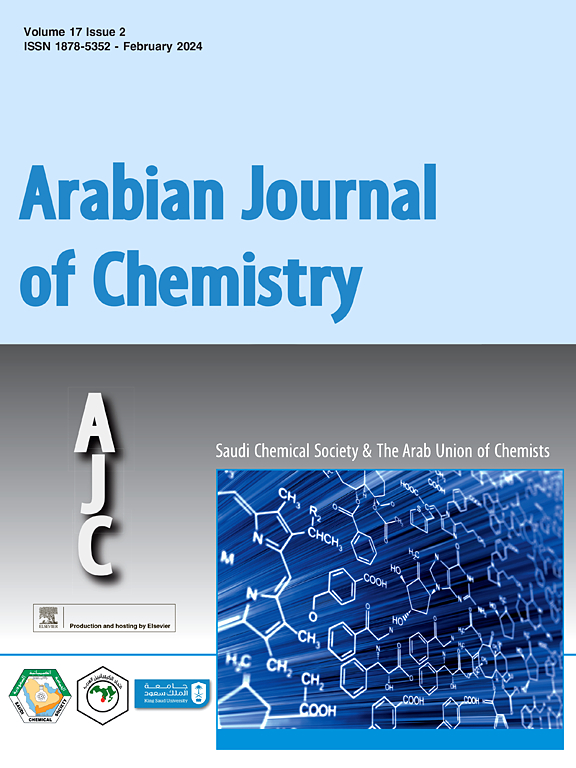多孔磷酸锆钠颗粒从水溶液中吸附铀(Ⅵ)的情况
IF 5.2
2区 化学
Q2 CHEMISTRY, MULTIDISCIPLINARY
引用次数: 0
摘要
磷酸锆是第一种人工生产的层状磷酸盐,可以从溶液中吸附各种核素。磷酸锆钠(NZP)是α-磷酸锆(α-ZrP)的一种。制备了直径大于 ∼3 mm 的多孔磷酸锆钠颗粒(p-NZP-P),并将其用于铀吸附。p-NZP-P 可在溶液中浸泡 5 天以上而不会溶解和结构坍塌。通过静态和动态吸附试验研究了溶液中 p-NZP-P 对铀(Ⅵ)的吸附特性。利用各种表征方法对合成的 p-NZP-P 进行了详细分析,以研究其特性和结构变化。在静态吸附实验中,当铀(Ⅵ)的初始浓度为 100 mg/L,pHinitial = 4.5,T = 25 ℃时,平衡吸附容量达到 77.5 ± 1.5 mg-g-1。当初始铀浓度从 100 mg-L-1 增加到 300 mg-L-1,温度从 15 ℃ 增加到 55 ℃ 时,铀吸附量分别增加了 ∼69 % 和 ∼215 %。此外,当初始 pH 值从 2.5 升至 4.5 时,铀吸附量增加了 ∼541 %,而当初始 pH 值从 4.5 升至 7.0 时,铀吸附量减少了 ∼39 %。吸附数据符合假二阶动力学模型和 Langmuir 等温线模型,也符合吸附容量的理论预测值(∼199.9 mg-g-1)。动态吸附实验结果表明,降低质量、增加流速和初始 U(Ⅵ)浓度都会缩短突破时间。动态吸附数据与托马斯模型十分吻合。表征证实了其多孔特性,而铀(Ⅵ)的吸附机理则与 -OH 配位和离子交换有关。放射性稀土废水处理试验表明,p-NZP-P 具有良好的稳定性和高效性,可能成为潜在的铀吸附剂。本文为在实际应用场景中开发处理放射性废水的实用材料提供了机会。本文章由计算机程序翻译,如有差异,请以英文原文为准。
U(Ⅵ) sorption by porous sodium zirconium phosphate pellets from aqueous solution
Zirconium phosphate is the first artificially produced layered phosphate that can sorb a variety of nuclides from solutions. Sodium zirconium phosphate (NZP) was a type of α-zirconium phosphate (α-ZrP). The porous sodium zirconium phosphate pellets (p-NZP-P) with a diameter of more than ∼3 mm were prepared and used for uranium sorption. The p-NZP-P could be immersed in solutions for more than 5 days without dissolving and structurally collapsing. The sorption properties of U(Ⅵ) on p-NZP-P in solutions were investigated by both static and dynamic sorption tests. Synthetic p-NZP-P was analyzed in detail using various characterizations to investigate their character and structural changes. In the static sorption experiment, the equilibrium sorption capacity reached the 77.5 ± 1.5 mg·g−1 when the initial concentration of U(Ⅵ) was 100 mg/L, pHinitial = 4.5, T = 25 ℃. Uranium sorption increased by ∼69 % and ∼215 %, respectively, when the initial uranium concentration was increased from 100 to 300 mg·L−1 and the temperature was increased from 15 to 55 °C. Furthermore, uranium sorption increased by ∼541 % when the initial pH increased from 2.5 to 4.5, while it decreased by ∼39 % when the initial pH increased from 4.5 to 7.0. The sorption data corresponded to the pseudo-second-order kinetic model and the Langmuir isotherm model, as well as the theoretically predicted value of sorption capacity (∼199.9 mg·g−1). The results of the dynamic sorption experiment showed that decreasing the quality, increasing the flow rate and the initial U(Ⅵ) concentration would shorten the breakthrough time. The dynamic sorption data agreed well with the Thomas model. The characterization confirmed the porous properties, while the U(Ⅵ) sorption mechanisms relate to –OH coordination and ion exchange. A radioactive rare earth wastewater treatment test suggested that p-NZP-P could be the potential uranium sorbent due to its good stability and efficiency. This paper opened opportunities for the development of practical materials for treating radioactive wastewater in the application of actual scenarios.
求助全文
通过发布文献求助,成功后即可免费获取论文全文。
去求助
来源期刊

Arabian Journal of Chemistry
CHEMISTRY, MULTIDISCIPLINARY-
CiteScore
10.80
自引率
3.30%
发文量
763
审稿时长
63 days
期刊介绍:
The Arabian Journal of Chemistry is an English language, peer-reviewed scholarly publication in the area of chemistry. The Arabian Journal of Chemistry publishes original papers, reviews and short reports on, but not limited to: inorganic, physical, organic, analytical and biochemistry.
The Arabian Journal of Chemistry is issued by the Arab Union of Chemists and is published by King Saud University together with the Saudi Chemical Society in collaboration with Elsevier and is edited by an international group of eminent researchers.
 求助内容:
求助内容: 应助结果提醒方式:
应助结果提醒方式:


